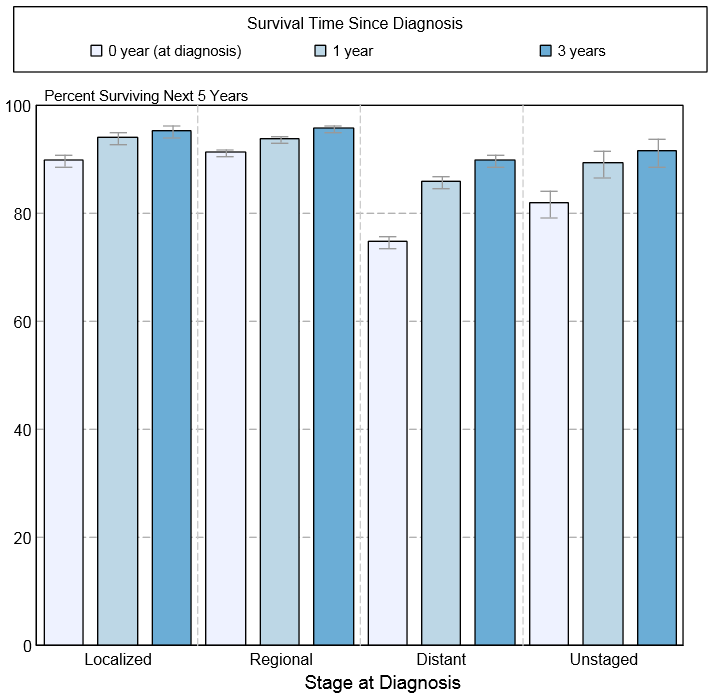Hodgkin's lymphoma natural history, complications and prognosis
|
Hodgkin's lymphoma Microchapters |
|
Diagnosis |
|---|
|
Treatment |
|
Case Studies |
|
Hodgkin's lymphoma natural history, complications and prognosis On the Web |
|
American Roentgen Ray Society Images of Hodgkin's lymphoma natural history, complications and prognosis |
|
FDA on Hodgkin's lymphoma natural history, complications and prognosis |
|
CDC on Hodgkin's lymphoma natural history, complications and prognosis |
|
Hodgkin's lymphoma natural history, complications and prognosis in the news |
|
Blogs on Hodgkin's lymphoma natural history, complications and prognosis |
Editor-In-Chief: C. Michael Gibson, M.S., M.D. [1]; Associate Editor(s)-in-Chief: Sowminya Arikapudi, M.B,B.S. [2] Mohsen Basiri M.D.
Overview
Hodgkin's lymphoma has a bimodal age distribution and both children and adult may be affected. The early peak occurs in the middle-to-late 20s and the second peak after age 50 years. Treatment outcomes of Hodgkin’s lymphoma are excellent and five-year survival rates are more than 80%. Owing to modern therapies, the natural history of untreated Hodgkin’s lymphoma is actually difficult to determine. Survivors are at risk for relapse, second primary malignancies, cardiovascular complications and other treatment-related toxicities. Prognosis is based on the stage of the disease and other prognostic factors. The early stage of the Hodgkin's lymphoma is associated with the most favorable prognosis. The 5-year survival rate of patients with Hodgkin's lymphoma varies with the stage of the disease.
Natural History
Complications
Prognosis
Prognostic factors for early (Stage I and II) Hodgkin's lymphoma[1]
- Hodgkin's lymphoma are divided into favorable and unfavorable groups based on prognostic factors.
- Early favorable Hodgkin's lymphoma
- Early favorable Hodgkin's lymphoma means that no factors listed below are present.
- Early unfavorable Hodgkin's lymphoma
- Early unfavorable Hodgkin's lymphoma means that one or more of the following factors are present:
- Bulky disease
- Larger than one-third the width of the chest
- At least 10 cm in its greatest dimension in areas other than the chest
- Presence of extra nodal disease (in areas other than the lymph nodes)
- 3 or more areas of lymph node involvement
- Erythrocyte sedimentation rate (ESR) of 50 mm/h or higher
- Mixed cellularity Hodgkin's lymphoma
- Presence of B symptoms
- Unexplained fever over 38°C
- Drenching night sweats
- Unexplained weight loss – loss of more than 10% of original body weight within the last 6 months
Prognostic factors in advanced (stage III and IV) Hodgkin's lymphoma[2]
- The International Prognostic Factors Project (IPFP) has developed an international prognostic score (IPS) based on 7 adverse factors for advanced (stage III and IV) Hodgkin's lymphoma. The factors that are present are combined to give a single score between 0 and 7.
- Advanced favorable Hodgkin's lymphoma
- Advanced favorable Hodgkin's lymphoma means that 0 to 3 factors listed below are present.
- Advanced unfavorable Hodgkin's lymphoma
- Advanced unfavorable Hodgkin's lymphoma means that 4 or more of the following factors are present:
- Stage IV disease
- Age 45 years or older
- Male sex
- Albumin level less than 4.0 g/dL
- Hemoglobin level less than 10.5 g/dL
- White blood cell (WBC) count at least 15,000/mm3
- Lymphocyte count less than 600/mm3 or less than 8% of the total WBC count
5-Year Survival
- Between 2004 and 2010, the 5-year relative survival of patients with Hodgkin's lymphoma was 87.7%.[3]
- When stratified by age, the 5-year relative survival of patients with Hodgkin's lymphoma was 90.5% and 52.8% for patients <65 and ≥ 65 years of age respectively.[3]
- The survival of patients with Hodgkin's lymphoma varies with the stage of the disease. Shown below is a table depicting the 5-year relative survival by the stage of Hodgkin's lymphoma:[3]
| Stage | 5-year relative survival (%), (2004-2010) |
| All stages | 85.3% |
| Localized | 90.8% |
| Regional | 92.1% |
| Distant | 76.2% |
| Unstaged | 80.7% |
- The survival of patients with Hodgkin's lymphoma also varies with the subtype of Hodgkin's lymphoma. Shown below is the 5-year relative survival by the subtype of Hodgkin's lymphoma:[3]
- Classical Hodgkin's lymphoma: 84.8%
- Lymphocyte-rich: 87.1%
- Mixed cellularity: 80%
- Lymphocyte-depleted: 56.6%
- Nodular sclerosis: 89.4%
- Classical Hodgkin's lymphoma not otherwise specified: 75.2%
- Nodular lymphocyte predominant Hodgkin's lymphoma: 95.3%
- Classical Hodgkin's lymphoma: 84.8%
- Shown below is an image depicting the 5-year conditional relative survival (probability of surviving in the next 5-years given the cohort has already survived 0, 1, 3 years) between 1998 and 2010 of Hodgkin's lymphoma by stage at diagnosis according to SEER. These graphs are adapted from SEER: The Surveillance, Epidemiology, and End Results Program of the National Cancer Institute.[3]
References
- ↑ Hodgkin-lymphoma. Canadian Cancer Society. http://www.cancer.ca/en/cancer-information/cancer-type/hodgkin-lymphoma/diagnosis/?region=ab Accessed on September 16, 2015
- ↑ Hodgkin-lymphoma. Canadian Cancer Society. http://www.cancer.ca/en/cancer-information/cancer-type/hodgkin-lymphoma/diagnosis/?region=ab Accessed on September 16, 2015
- ↑ 3.0 3.1 3.2 3.3 3.4 Howlader N, Noone AM, Krapcho M, Garshell J, Miller D, Altekruse SF, Kosary CL, Yu M, Ruhl J, Tatalovich Z,Mariotto A, Lewis DR, Chen HS, Feuer EJ, Cronin KA (eds). SEER Cancer Statistics Review, 1975-2011, National Cancer Institute. Bethesda, MD, http://seer.cancer.gov/csr/1975_2011/, based on November 2013 SEER data submission, posted to the SEER web site, April 2014.
